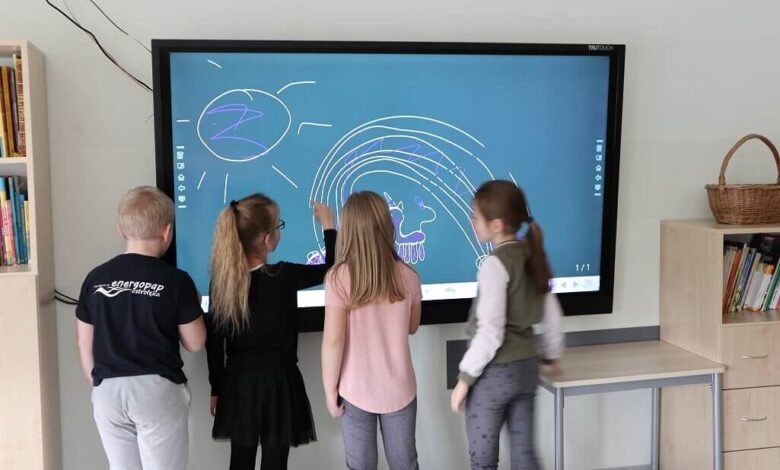Interactive Flat Panel Classroom: Transforming Education for the 21st Century

In recent years, technology has dramatically reshaped the landscape of education, leading to a shift from traditional teaching methods to more dynamic and engaging approaches. One of the most significant advancements in this realm is the introduction of interactive flat panels in classrooms. These high-tech displays are revolutionizing how educators teach and how students learn, promoting collaboration, engagement, and a more personalized learning experience. This article delves into the features, benefits, challenges, and future prospects of interactive flat panel classroom, highlighting their role in enhancing education for the 21st century.
What is an Interactive Flat Panel?
An interactive flat panel (IFP) is a large touchscreen display that combines the functionality of a traditional whiteboard with the capabilities of modern interactive technology. Unlike standard projectors or whiteboards, IFPs offer a more responsive and versatile platform for teaching and learning. They allow educators to display digital content, annotate directly on the screen, and facilitate collaborative activities among students.
Key Features of Interactive Flat Panels
Interactive flat panels are equipped with various features designed to enhance classroom interactions and learning experiences:
- Touchscreen Technology: IFPs utilize advanced touchscreen technology that supports multi-touch gestures, allowing multiple users to interact with the display simultaneously. This feature fosters collaboration and engagement, enabling students to work together on projects or problem-solving activities.
- High-Definition Display: Most interactive flat panels feature high-resolution displays, providing clear and vibrant visuals. This quality ensures that students can easily read text and view images, videos, and presentations, regardless of their position in the classroom.
- Integration with Educational Software: IFPs are compatible with various educational software applications, enabling teachers to create interactive lessons that cater to diverse learning styles. These applications can include everything from presentation tools to collaborative learning platforms.
- Digital Annotation: Teachers can write, highlight, or draw directly on the interactive display using digital pens or their fingers. This capability allows for real-time note-taking, enhancing the visual learning experience and enabling students to follow along more effectively.
- Screen Sharing and Collaboration: IFPs can easily connect to multiple devices, allowing teachers and students to share content from laptops, tablets, or smartphones. This feature encourages collaborative learning and facilitates group discussions.
- Built-in Audio and Video Capabilities: Many interactive flat panels come with integrated speakers and microphones, allowing teachers to play multimedia content and conduct virtual lessons or discussions seamlessly.
- User-Friendly Interface: Interactive flat panels often have intuitive interfaces that make them easy for teachers and students to navigate. This accessibility reduces the learning curve associated with new technology.
Benefits of Interactive Flat Panel Classrooms
The implementation of interactive flat panels in classrooms offers numerous advantages for educators and students alike:
- Enhanced Engagement: The interactive nature of flat panels captivates students’ attention, making learning more enjoyable. The ability to interact directly with the display encourages active participation and boosts motivation.
- Improved Collaboration: IFPs promote collaborative learning by allowing multiple students to work together on the same screen. This collaboration fosters teamwork, communication, and problem-solving skills—essential competencies for the 21st century.
- Tailored Learning Experiences: Interactive flat panels enable teachers to customize lessons to suit individual students’ needs. By integrating various multimedia resources, educators can address different learning styles and preferences, ensuring that all students have the opportunity to succeed.
- Instant Feedback: Many interactive flat panels include assessment tools that allow teachers to gauge student understanding in real time. This immediate feedback enables educators to adjust their teaching strategies on the fly, ensuring that students grasp key concepts before moving on.
- Access to Diverse Resources: With an interactive flat panel, teachers can access a wealth of online resources, multimedia content, and educational applications. This access enriches lessons and makes learning more relevant to students’ lives.
- Facilitating Distance Learning: In today’s digital age, interactive flat panels can bridge the gap between in-person and remote learning. They enable seamless video conferencing and online collaboration, ensuring that students can participate in lessons regardless of their location.
- Environmentally Friendly: By reducing the need for paper and traditional whiteboards, interactive flat panels contribute to a more sustainable classroom environment. Teachers can save resources while enhancing the learning experience.
Challenges of Implementing Interactive Flat Panel Classrooms
Despite their many benefits, the adoption of interactive flat panels in classrooms also presents several challenges:
- Initial Costs: The investment required to purchase and install interactive flat panels can be substantial, especially for schools with limited budgets. This cost may extend beyond the hardware to include software licenses and ongoing maintenance.
- Training and Support: To maximize the potential of interactive flat panels, teachers need adequate training and ongoing support. Professional development programs should be established to ensure educators are comfortable and competent using the technology.
- Technical Issues: Like any technology, interactive flat panels may encounter technical problems, such as software glitches or connectivity issues. Reliable technical support is essential to minimize disruptions during lessons.
- Distraction Risks: If not used effectively, interactive flat panels can become a source of distraction for students. Teachers must establish clear guidelines for their use to maintain focus on educational objectives.
- Equity Concerns: Not all students have equal access to technology outside of school, leading to potential disparities in learning opportunities. Educators must be mindful of this issue when implementing interactive flat panels in the classroom.
- Resistance to Change: Some educators may be resistant to adopting new technology, preferring traditional teaching methods. Encouraging a cultural shift towards technology integration may require time and effort.
Future Trends in Interactive Flat Panel Classrooms
As technology continues to advance, the future of interactive flat panel classrooms looks promising. Several emerging trends are expected to shape their development:
- AI and Personalized Learning: Artificial intelligence is likely to play a significant role in the evolution of interactive flat panels. AI-driven tools can analyze student performance and adapt content to meet individual learning needs, providing a more personalized experience.
- Augmented and Virtual Reality Integration: The incorporation of augmented reality (AR) and virtual reality (VR) technologies into interactive flat panels can provide immersive learning experiences. Students may be able to explore virtual environments, conduct simulations, and engage with 3D models, making learning more experiential.
- Enhanced Connectivity: Future interactive flat panels are expected to offer improved connectivity options, allowing seamless integration with various devices and platforms. This will facilitate collaboration and content sharing among students and teachers.
- Data Analytics: Advanced data analytics tools may be integrated into interactive flat panels, providing insights into student performance and engagement. Educators can use this data to inform instructional decisions and improve student outcomes.
- Sustainable Design: As educational institutions increasingly focus on sustainability, future interactive flat panels may prioritize eco-friendly materials and energy-efficient designs. This shift aligns with the growing commitment to environmental responsibility in education.
- Cloud-Based Solutions: Cloud technology will enable easier access to resources and data storage. Teachers can create and share lessons from anywhere, and students can access materials on their devices, whether in the classroom or at home.
- Integration with Smart Classroom Technologies: Interactive flat panels may increasingly be integrated with other smart classroom technologies, such as digital signage, smart lighting, and classroom management systems. This integration can create a more cohesive and efficient learning environment.
Case Studies: Successful Implementation of Interactive Flat Panel Classrooms
Several educational institutions around the world have successfully implemented interactive flat panels, showcasing their impact on teaching and learning:
- Example: St. Joseph’s College, Australia
St. Joseph’s College in Australia has embraced interactive flat panels across its classrooms. Teachers utilize the technology to deliver dynamic lessons, incorporating multimedia content and interactive activities that engage students. The school reported increased student participation and improved academic performance as a result of this integration. - Example: Kamehameha Schools, Hawaii
Kamehameha Schools in Hawaii has implemented interactive flat panels in its classrooms to enhance collaboration and communication among students. The school uses the technology to facilitate group projects, enabling students to brainstorm ideas, share resources, and present their findings effectively. Teachers have noted a marked improvement in teamwork skills and student confidence. - Example: Colegio Americano, Mexico
Colegio Americano in Mexico City has transformed its learning environment with interactive flat panels. The school provides professional development for teachers to ensure they are comfortable using the technology. As a result, educators have created innovative lesson plans that incorporate gamification, virtual field trips, and real-time assessments, leading to increased student engagement and satisfaction.
Conclusion
Interactive flat panels represent a significant advancement in educational technology, transforming classrooms into interactive, engaging, and collaborative learning environments. By enhancing student engagement, fostering collaboration, and providing personalized learning experiences, these devices have the potential to reshape education for the 21st century.
Despite the challenges associated with implementing interactive flat panel classroom, the benefits far outweigh the drawbacks. As technology continues to evolve, the future of interactive flat panel classrooms looks bright, with advancements in artificial intelligence, augmented reality, and data analytics promising to further enhance the learning experience.
Educators, administrators, and policymakers must embrace this technological shift and invest in the necessary resources, training, and support to ensure that all students benefit from the opportunities presented by interactive flat panels. By doing so, they can prepare students for success in an increasingly complex and interconnected world, equipping them with the skills and knowledge needed to thrive in the future.




